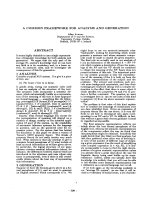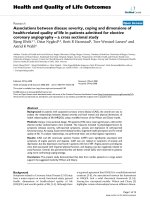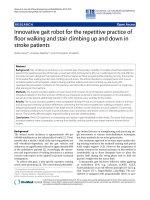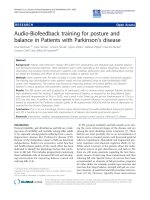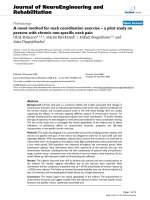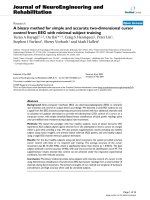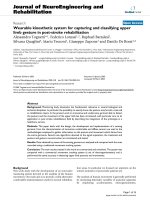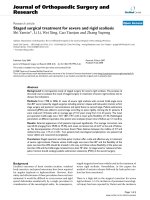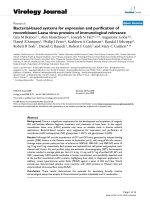Báo cáo hóa học: " Editorial Novel Techniques for Analysis and Design of Cross-Layer Optimized Wireless Sensor Networks" docx
Bạn đang xem bản rút gọn của tài liệu. Xem và tải ngay bản đầy đủ của tài liệu tại đây (432.17 KB, 3 trang )
Hindawi Publishing Corporation
EURASIP Journal on Wireless Communications and Networking
Volume 2007, Article ID 31647, 3 pages
doi:10.1155/2007/31647
Editorial
Novel Techniques for Analysis and Design of Cross-Layer
Optimized Wireless Sensor Networks
Mischa Dohler,
1
Taieb Znati,
2
Stavros Toumpis,
3
and Lionel M. Ni
4
1
France T
´
el
´
ecom R&D, 28 Chemin du Vieux Ch
ˆ
ene, 38243 Meylan Cedex, France
2
Department of Computer Science, University of Pittsburgh, Pittsburgh, PA 15260, USA
3
University of Cyprus, Kallipoleos 75, P.O. Box 20537, 1678 Nicosia, Cyprus
4
Department of Computer Science and Engineering, The Hong Kong University of Science and Technology,
Clear Water Bay, Kowloon, Hong Kong, China
Received 31 May 2007; Accepted 31 May 2007
Copyright © 2007 Mischa Dohler et al. This is an open access article distributed under the Creative Commons Attribution License,
which permits unrestricted use, distribution, and reproduction in any medium, provided the original work is properly cited.
Out of the immense research activity of the last 10–15 years
on wireless multihop networks, wireless sensor networks
(WSNs) have emerged as perhaps the most important topol-
ogy, both in terms of their commercial potential and also
from a scientific point of view.
WSNs are important commercially because of their many
applications, both on the military and on the civilian do-
mains, for example, intruder detection, the structural moni-
toring of large constructions such as skyscrapers and bridges,
the monitoring of wildlife, the tracking of contaminants in
the soil and the atmosphere, and so many others that have
already b een well documented in numerous survey papers.
Some of these applications have already proved to be com-
mercially viable and indeed financially very successful.
WSNs are also very important from a scientific point of
view, because of their unique features with respect to other
types of wireless networks: nodes are typically immobile and
are required to carr y a specific type of traffic(whichisadvan-
tageous), have extreme restrictions on the energy they con-
sume, the processing power they have, and the antennas they
can use (which is disadvantageous), and the data created at
different sensors may be strongly correlated (which is useful,
but only if we work hard to devise good algorithms that take
advantage of it).
Therefore, in the last few years we have experienced an
important shift in research activities, from research on gen-
eral purpose wireless networks, to more focused research
specifically on WSNs, taking into account their specific ad-
vantages and peculiar ities. An important recurring theme in
research in this field is the need for cross-layer design, w hich
arises firstly because of the nature of the wireless channel,
and secondly because, in contrast to almost all other types
of wireless and wired networks, WSNs are built for a specific
application in mind, and so al l layers must be cognizant of
the features of this application and coordinate in executing it.
Therefore, algorithms must be designed to either span mul-
tiple layers or focus on one layer, but be cognizant of what
happens in other layers. Furthermore, a meaningful analysis
of the operation of the network cannot be performed exclu-
sively on one layer, but must encompass more than one, in
many multiple cases.
The papers that appear in this issue have been carefully
selected after a rigorous review process, and represent the
state of the art on cross-layer design for WSNs. All of them
take into account the unique peculiarities, advantages, and
shortcomings of wireless sensor networks, and propose algo-
rithms and analyses that significantly advance research in the
field. We sincerely hope you will enjoy reading them as much
as we did.
The authors of the first paper “An adaptive time-spread
multiple-access MAC policy for wireless sensor networks”,
K. Oikonomou and I. Stavrakakis, deal with the problem
of medium access control, which they attempt to tackle us-
ing a time division multiple access (TDMA) protocol termed
the A-policy. TDMA protocols are particularly well suited for
sensor networks, firstly because the topology changes slowly
due to low or no node mobility, and in addition with such
protocols it is easier to ensure collision-free operation, which
is very important in order to conserve energy. The A-policy
cleverly avoids collisions while ensuring that transmissions
are packed close together. It does this by carefully ramping
up the traffic during a transient period of the operation of
the protocol.
G. Manes et al., in their paper titled “Efficient MAC
protocols for wireless sensor networks endowed with di-
rective antennas: a cross-layer solution,” make a convincing
2 EURASIP Journal on Wireless Communications and Networking
argument for the use of directional antennas, a technology
which is challenging to use in WSNs but nevertheless leads,
as the authors show, to important gains in the performance.
The authors use directional antennas as part of the direc-
tive synchronous transmission asynchronous reception (D-
STAR) protocol, which also contains a sleep mechanism, to
improve the energy consumption.
In the third paper “On traffic load distribution and load
balancing in dense wireless multihop networks” E. Hyyti and
J. Virtamo also do not shy away from the problem of having
a large number of nodes, but rather embrace it. They adopt
anovelmacroscopic view of the network, under which the
network is modeled as a continuum of nodes, and routes be-
come continuous lines. In this context, they derive bounds
on the traffic load of each point in the network using analo-
gies with physics, and use them to perform load balancing.
Similar continuum formulations have appeared in the liter-
ature only recently, but initial results based on the method
are ver y promising; this work presents a significant push for-
ward. Note that the work applies not only to sensor networks,
but to general wireless networks as well, and should be read
with this in mind.
You have got them rolled-out—your million of sensors.
What is next? Clearly, using all sensors at the same time will
lead to areas being monitored multifold and hence energy
waste. One of the pertinent issues is thus which subset of
sensors to use such that energy use is minimized but cov-
erage is maintained. The authors of the forth paper “Scalable
coverage maintenance for dense wireless sensor networks”, J.
Lu et al., have proposed an intriguing low complexity scheme
which enables the coverage to be maintained in a scalable and
energy-efficient manner.
In the fifth paper, titled “Extending the lifetime of sen-
sor networks through adaptive reclustering,” G. Ferrari and
M. Martal
`
o propose an adaptive reclustering algorithm that
leads to considerable improvements in terms of the lifetime
of the network. The particular application they have in mind
is the sensing of a binary event by sensors that are error-
prone, and also communicate with each other and a central
access point (AP) through an error-prone channel. The au-
thors consider the use of clustering, so that all the sensors
in a cluster send their observations to a cluster head that pro-
cesses them, makes a decision, and then forwards them to the
AP. In this setting, the authors show that absence of recluster-
ing leads to reduced network lifetimes, the optimal clustering
strategy is organizing the nodes in a few large clusters, and
the observation of the phenomena should be frequent, in or-
der to minimize the penalties associated with the reclustering
procedure.
Synchronization has been and remains one of the biggest
problems in wireless communication systems, the more so
if the systems are distributed as in the case of WSNs.
The sixth paper, titled “Distributed time synchronization in
wireless sensor networks with coupled discrete-time oscil-
lators,” by O. Simeone and U. Spagnolini, proposes an en-
tirely novel time synchronization approach based on pulse-
coupled oscillators, facilitating synchronization even when
the clocks have different free-oscillation frequencies. Paral-
lels are drawn to the more conventional phase-locked loop
approach and—being a g reat asset—practical implementa-
tions over a bandlimited noisy channel are discussed.
As pointed out by Coronis—a company having com-
mercially rolled out more than one million wireless sensors
in France—connectivity between the nodes is a remaining
problem; currently, the majority of the links are of long range
and low reliability. Most works on MAC and routing proto-
cols as well as link connectivity, however, assume an on/off
connectivity, that is, a link is either available all the time or
not at all. The seventh paper “Impact of radio link unreliabil-
ity on the connectivity of wireless sensor networks”, by J M.
Gorce et al., in contrast, extends the mathematical frame-
work of connectivity to encompass unreliable links which
might be the result of channel variations or a node appear-
ing/disappearing after recharging/depletion. This approach
facilitates a quantification of the contribution of unreliable
long links to an increase of the connectivity of WSNs and
hence the potential design of energy-optimized MAC (via the
energy detection threshold) and routing (via the reliability
threshold) protocols.
More sophisticated application-driven sensor networks
will require each sensor to transmit at different bit rates
and reliabilities. The eighth paper, titled “An energy-efficient
adaptive modulation suitable for wireless sensor networks
with SER and throughput constraints” and authored by J.
Garz
´
as et al., presupposes a centralized network topology
and takes a PHY/MAC cross-layer approach where the PHY
selects a near-optimum modulation scheme and the MAC
assigns a near-optimal number of time slots. The proposed
approach is globally energy efficient and hence allows the
lifetime of the network to be maximized whilst obeying
application-dependent requirements.
The ninth paper, by C. Ma et al., is titled “Constructing
battery-aware virtual backbones in wireless sensor networks”
and is a fine example of how an improved modeling of the
network can alter our perception of what its optimal opera-
tion should be. In particular, the authors focus on the con-
struction of backbones for wireless sensor networks, that is,
subsets of nodes that span the network, and all other nodes
are within one hop from one of them. Such structures can
be used for a million different things, notably routing and
data aggregation. Traditional wisdom suggests that, from an
energy efficiency perspective, the backbone should be a min-
imum connected dominating set (MCDS). However, the au-
thors of this paper show that this presupposes a simplistic
battery model that does not consider the effects of battery
recharge. Under a more realistic battery model, that includes
this effect, the MCDS is no longer appropriate. The authors
show that their minimum battery-aware connected doming
sets (MBACDSs) achieve superior performance, and develop
distributed algorithms for finding them.
The commercial attractiveness of some WSNs comes
from their ability to gather and aggregate very heteroge-
neous sets of data. This is usually performed at differ-
ent data rates—leading to heavily overheaded multirate
query systems. In the tenth paper, titled “An energy-efficient
framework for multirate query in wireless sensor networks,”
Mischa Dohler et al. 3
Y. Chen et al. propose to broadcast a single consolidated data
stream, which—using exposed techniques over the corre-
lated set of data—facilitates the reconstruction of the data
streams at lower frequencies from the consolidated stream
at a higher frequency. The proposed energy-efficient frame-
work extends to a path-sharing routing tree construction
method and yields significant energy gains.
One of the boldest ideas to come out in recent years in re-
sponse to the stringent energy requirements of wireless sen-
sornetworksishavingmobile sinks. For some applications,
such as data gathering in plantations with high delay toler-
ance, this is perfectly acceptable. The differentiation with re-
spect to WSNs with immobile sinks is that now packets are
delivered to the sink, still using multiple hops, but only when
the sink happens to be relatively close. In our last paper, titled
“HUMS: an autonomous moving strategy for mobile sinks in
data-gathering sensor networks,” Y. Bi et al. develop an inno-
vative algori thm for performing the sink movement, that is
based on the observation that it is best for the sink to move
close to high energy nodes, which would be more willing
to participate in the forwarding of data coming from other
nodes. A comparison with other schemes shows significant
improvements.
We would like to thank the authors of all submitted pa-
pers (both those that were accepted and those that, regret-
tably, could not fit in) for considering our special issue for
disseminating their work. We extend our gratitude to the
many, very conscientious reviewers for sacrificing so much
of their time in order to make this special issue a success.
ACKNOWLEDGMENTS
We would like to thank the devoted staff of Hindawi for their
high level of professionalism, and Philip Regalia, the Editor-
in-Chief of the journal, for trusting us with this important
assignment and helping us fulfill it successfully.
Mischa Dohler
Taieb Zna ti
Stavros Toumpis
Lionel M. Ni
